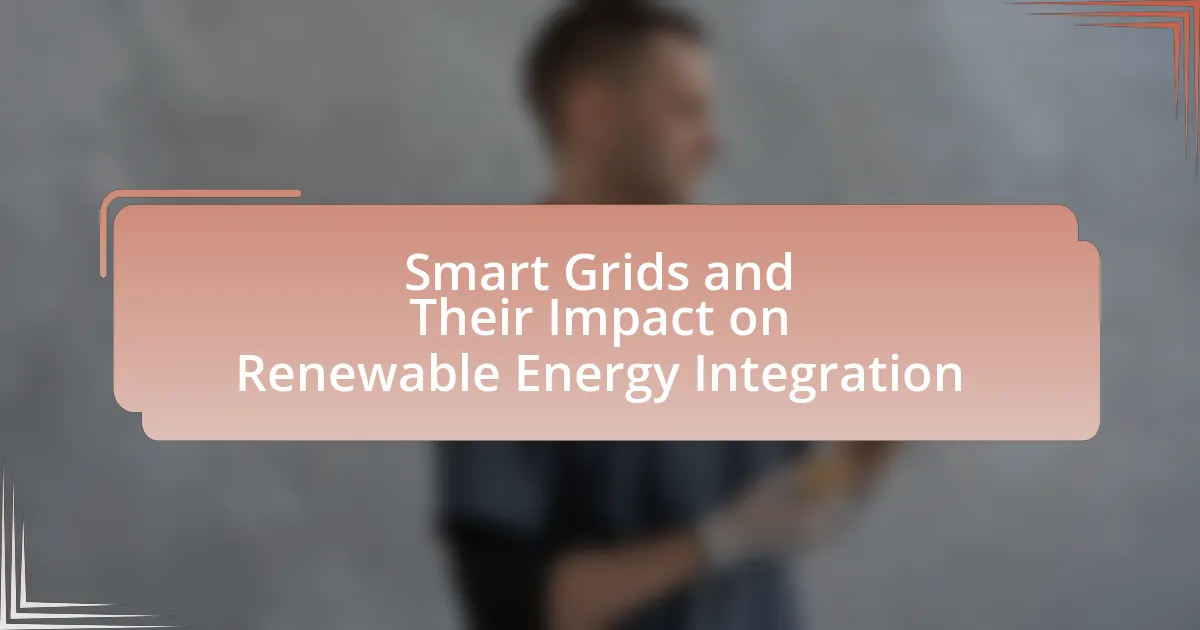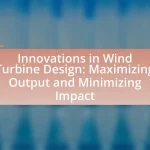Smart grids are advanced electrical systems that leverage digital technology to enhance the management and distribution of electricity, significantly impacting renewable energy integration. This article explores the functionality of smart grids in modern energy distribution, highlighting their role in improving efficiency, reliability, and sustainability. Key technologies integral to smart grids, such as advanced metering infrastructure and demand response systems, are discussed, along with the economic advantages and challenges associated with their implementation. Additionally, the article addresses how smart grids facilitate the integration of renewable energy sources, improve grid resilience, and the importance of regulatory frameworks and government incentives in promoting their adoption.
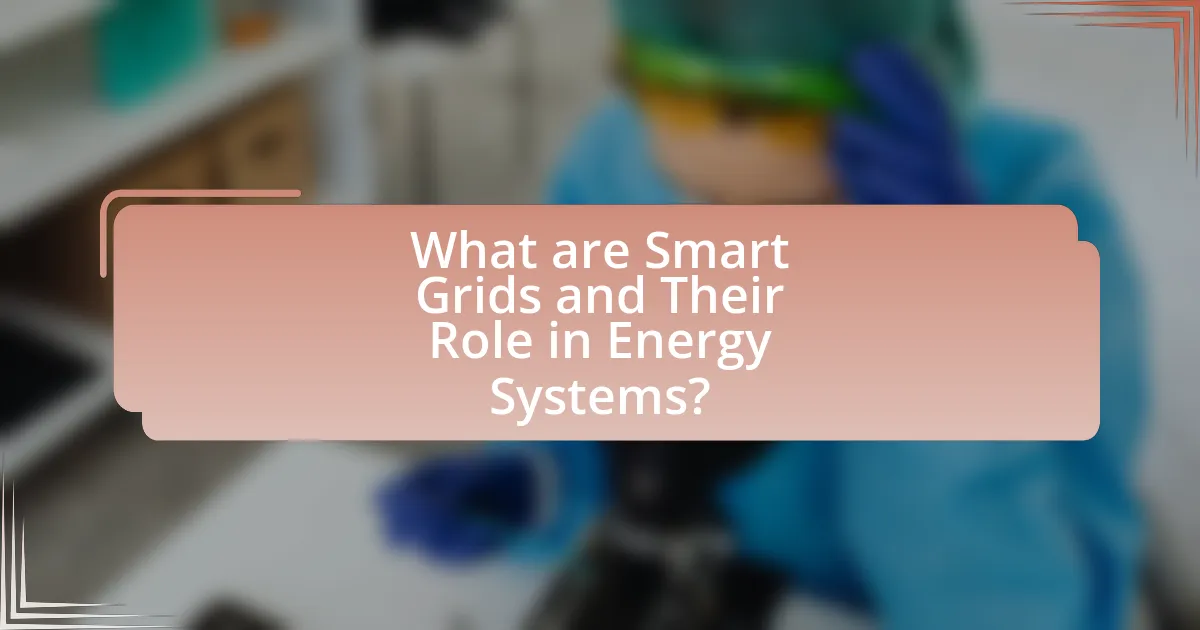
What are Smart Grids and Their Role in Energy Systems?
Smart grids are advanced electrical grids that utilize digital technology to monitor and manage the transport of electricity from all generation sources to meet the varying electricity demands of end users. They enhance the reliability, efficiency, and sustainability of energy systems by enabling two-way communication between utilities and consumers, facilitating real-time data exchange, and integrating renewable energy sources more effectively. For instance, according to the U.S. Department of Energy, smart grid technologies can reduce energy costs by up to 20% and improve grid reliability by minimizing outages and enhancing response times.
How do Smart Grids function in modern energy distribution?
Smart grids function in modern energy distribution by utilizing advanced communication technologies and data analytics to enhance the efficiency, reliability, and sustainability of electricity delivery. They integrate various energy sources, including renewable energy, by enabling real-time monitoring and management of energy flows, which allows for better demand response and grid stability. For instance, smart meters provide consumers with detailed usage data, facilitating energy conservation and peak load management. Additionally, the integration of distributed energy resources, such as solar panels and wind turbines, is optimized through smart grid technologies, which can dynamically adjust to fluctuations in energy supply and demand. This capability is supported by the U.S. Department of Energy’s Smart Grid System Report, which highlights that smart grids can reduce energy losses by up to 30% and improve the integration of renewable energy sources by providing a more flexible and responsive grid infrastructure.
What technologies are integral to Smart Grids?
Smart Grids rely on several integral technologies, including advanced metering infrastructure (AMI), demand response systems, distributed energy resources (DER) integration, and communication networks. AMI enables real-time data collection and two-way communication between utilities and consumers, enhancing energy management. Demand response systems allow for the adjustment of consumer energy usage based on supply conditions, promoting efficiency. DER integration facilitates the incorporation of renewable energy sources, such as solar and wind, into the grid. Communication networks, including IoT and wireless technologies, support the seamless exchange of information across the grid, ensuring reliability and responsiveness. These technologies collectively enhance the efficiency, reliability, and sustainability of energy systems.
How do Smart Grids enhance energy efficiency?
Smart Grids enhance energy efficiency by utilizing advanced communication and automation technologies to optimize electricity distribution and consumption. These systems enable real-time monitoring and management of energy flows, allowing for better demand response and integration of renewable energy sources. For instance, according to the U.S. Department of Energy, Smart Grids can reduce energy consumption by up to 15% through improved grid management and consumer engagement. This efficiency is achieved by facilitating two-way communication between utilities and consumers, enabling users to adjust their energy usage based on real-time pricing and availability, thus minimizing waste and lowering costs.
Why is the integration of renewable energy important?
The integration of renewable energy is important because it enhances energy security and reduces greenhouse gas emissions. By incorporating sources like solar, wind, and hydroelectric power into the energy mix, countries can decrease their reliance on fossil fuels, which are finite and contribute significantly to climate change. According to the International Renewable Energy Agency (IRENA), renewable energy could account for 86% of global power demand by 2050, significantly lowering carbon emissions and promoting sustainable development. This transition not only mitigates environmental impacts but also fosters economic growth through job creation in the renewable sector.
What challenges do traditional grids face with renewable energy sources?
Traditional grids face significant challenges when integrating renewable energy sources, primarily due to their inherent inflexibility and reliance on centralized power generation. The intermittent nature of renewable sources, such as solar and wind, leads to fluctuations in energy supply that traditional grids are not designed to manage effectively. For instance, according to the U.S. Department of Energy, renewable energy generation can vary widely, with solar output dropping significantly during cloudy weather or at night, and wind generation being unpredictable. This variability can cause grid instability, requiring advanced management systems and storage solutions that traditional grids lack. Additionally, traditional grids often struggle with the increased complexity of distributed energy resources, which can complicate grid operations and require significant upgrades to infrastructure and technology to ensure reliability and efficiency.
How do Smart Grids address these challenges?
Smart Grids address challenges in renewable energy integration by enhancing the efficiency and reliability of electricity distribution. They utilize advanced technologies such as real-time data analytics, automated demand response, and decentralized energy management systems to optimize energy flow and accommodate variable renewable energy sources like solar and wind. For instance, according to the U.S. Department of Energy, Smart Grids can reduce energy losses by up to 30% and improve grid reliability, which is crucial for integrating intermittent renewable resources. Additionally, Smart Grids facilitate better communication between utilities and consumers, enabling more effective energy usage and supporting the transition to a more sustainable energy system.
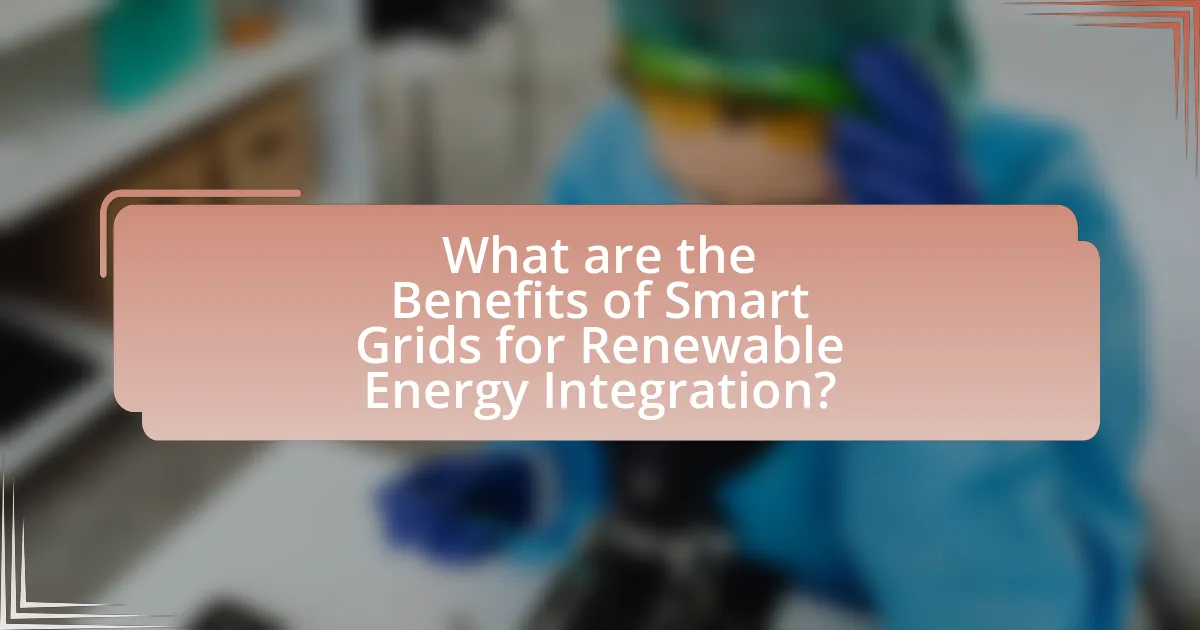
What are the Benefits of Smart Grids for Renewable Energy Integration?
Smart grids enhance renewable energy integration by improving efficiency, reliability, and flexibility in energy distribution. They enable real-time monitoring and management of energy flows, which facilitates the incorporation of variable renewable sources like solar and wind. For instance, smart grids utilize advanced metering infrastructure and communication technologies to balance supply and demand dynamically, reducing energy waste and optimizing resource use. According to the U.S. Department of Energy, smart grid technologies can increase the integration of renewable energy sources by up to 30%, significantly contributing to a cleaner energy mix and reducing greenhouse gas emissions.
How do Smart Grids facilitate the use of renewable energy?
Smart grids facilitate the use of renewable energy by enabling real-time monitoring and management of energy resources, which enhances the integration of variable renewable sources like solar and wind. They utilize advanced communication technologies and data analytics to optimize energy distribution, allowing for better demand response and energy storage solutions. For instance, smart grids can adjust energy supply based on real-time demand and generation data, reducing reliance on fossil fuels and minimizing energy waste. According to the U.S. Department of Energy, smart grid technologies can increase the share of renewable energy in the grid by up to 30%, demonstrating their effectiveness in promoting sustainable energy practices.
What impact do Smart Grids have on energy storage solutions?
Smart Grids significantly enhance energy storage solutions by enabling better integration and management of renewable energy sources. They facilitate real-time data exchange and communication between energy producers, consumers, and storage systems, optimizing energy flow and reducing waste. For instance, Smart Grids can predict energy demand and supply fluctuations, allowing for efficient charging and discharging of energy storage systems, such as batteries. This capability is evidenced by studies showing that Smart Grid technologies can increase the efficiency of energy storage utilization by up to 30%, thereby improving the overall reliability and sustainability of energy systems.
How do Smart Grids improve grid reliability and resilience?
Smart Grids enhance grid reliability and resilience by utilizing advanced technologies for real-time monitoring, automated control, and data analytics. These systems enable quicker detection and response to outages, reducing downtime and improving service continuity. For instance, according to the U.S. Department of Energy, Smart Grids can reduce outage durations by up to 30% through automated fault detection and isolation. Additionally, Smart Grids facilitate the integration of distributed energy resources, such as solar and wind, which diversifies energy supply and enhances system robustness against disruptions. This adaptability to varying energy sources further strengthens grid resilience, ensuring stable electricity delivery even during extreme weather events or equipment failures.
What economic advantages do Smart Grids provide?
Smart Grids provide significant economic advantages by enhancing energy efficiency, reducing operational costs, and enabling better integration of renewable energy sources. These systems utilize advanced technologies to optimize electricity distribution, which leads to lower energy losses and improved reliability. For instance, a study by the U.S. Department of Energy estimates that Smart Grid technologies could save consumers up to $200 billion over the next 20 years through reduced energy costs and improved grid management. Additionally, Smart Grids facilitate demand response programs, allowing consumers to adjust their energy usage during peak times, further lowering costs and stabilizing the grid.
How do Smart Grids reduce operational costs for energy providers?
Smart Grids reduce operational costs for energy providers by enhancing efficiency through real-time data management and automation. These systems enable utilities to monitor energy consumption patterns, optimize grid performance, and reduce energy losses. For instance, a study by the U.S. Department of Energy found that Smart Grid technologies can lead to a 10-30% reduction in operational costs by minimizing outages and improving demand response capabilities. Additionally, Smart Grids facilitate better integration of renewable energy sources, which can lower fuel costs and reduce reliance on traditional energy generation methods.
What financial incentives exist for adopting Smart Grid technologies?
Financial incentives for adopting Smart Grid technologies include federal and state grants, tax credits, and utility rebates. For instance, the U.S. Department of Energy offers funding through programs like the Smart Grid Investment Grant program, which allocated $4.5 billion to support Smart Grid projects. Additionally, the Investment Tax Credit (ITC) provides a 30% tax credit for solar energy systems, which can be integrated with Smart Grid technologies. Utility companies often provide rebates for customers who install Smart Grid-compatible devices, further encouraging adoption. These financial incentives are designed to reduce the initial costs associated with implementing Smart Grid technologies, thereby promoting their widespread adoption and enhancing renewable energy integration.
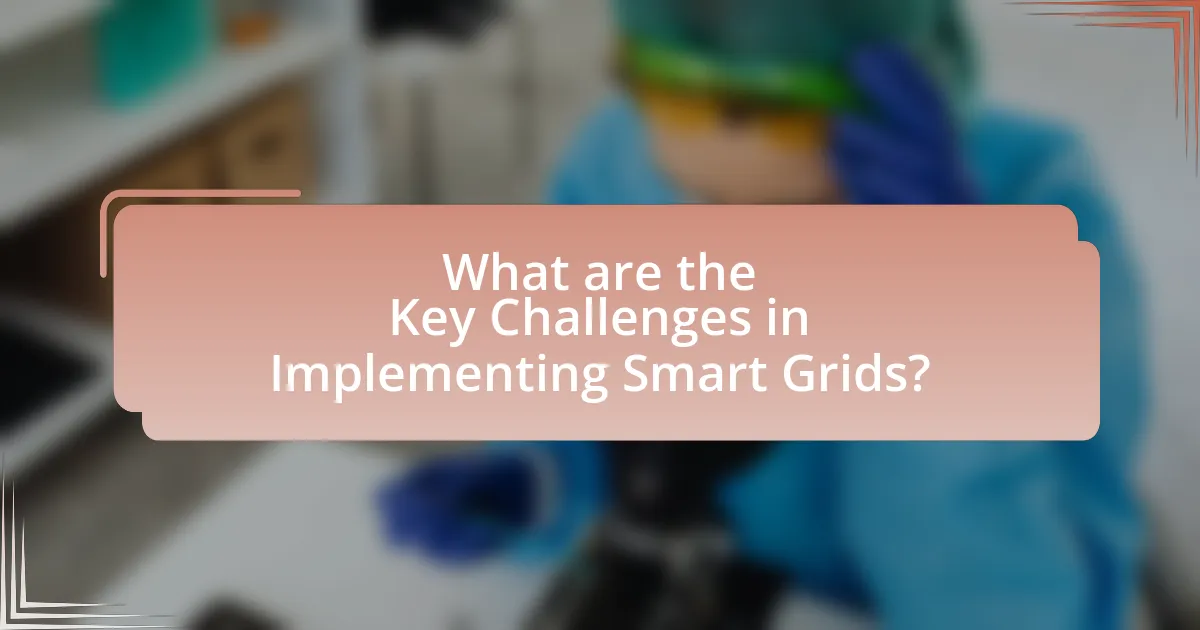
What are the Key Challenges in Implementing Smart Grids?
The key challenges in implementing smart grids include high initial costs, cybersecurity risks, and the need for regulatory frameworks. High initial costs arise from the investment required for advanced technologies and infrastructure upgrades, which can deter utilities and stakeholders. Cybersecurity risks are significant due to the increased connectivity and data exchange, making smart grids vulnerable to cyberattacks. Additionally, the lack of standardized regulatory frameworks can hinder the deployment of smart grid technologies, as inconsistent policies across regions create barriers to implementation. These challenges must be addressed to fully realize the benefits of smart grids in enhancing renewable energy integration.
What technical barriers exist in Smart Grid deployment?
Technical barriers in Smart Grid deployment include interoperability issues, cybersecurity vulnerabilities, and the need for advanced communication infrastructure. Interoperability challenges arise from the diverse technologies and standards used by different manufacturers, which can hinder seamless integration. Cybersecurity vulnerabilities pose risks as Smart Grids rely on digital communication, making them susceptible to cyberattacks; for instance, the 2015 Ukraine power grid attack highlighted the potential consequences of inadequate security measures. Additionally, the deployment of advanced communication infrastructure is essential for real-time data exchange and system management, yet many regions lack the necessary investment and resources to implement such technologies effectively.
How do cybersecurity concerns affect Smart Grid systems?
Cybersecurity concerns significantly affect Smart Grid systems by increasing vulnerability to cyberattacks, which can disrupt energy distribution and compromise data integrity. For instance, the 2015 cyberattack on Ukraine’s power grid demonstrated how hackers could remotely manipulate control systems, leading to widespread outages. Such incidents highlight the necessity for robust cybersecurity measures to protect critical infrastructure, as Smart Grids rely on interconnected devices and real-time data sharing, making them attractive targets for malicious actors. The potential for financial loss, operational disruption, and damage to public trust underscores the importance of addressing these cybersecurity challenges in the context of Smart Grid systems.
What are the interoperability issues with existing infrastructure?
Interoperability issues with existing infrastructure primarily stem from the lack of standardized communication protocols and data formats among various systems. This fragmentation leads to difficulties in data exchange and integration between legacy systems and modern smart grid technologies. For instance, many existing energy management systems utilize proprietary protocols, which complicates the integration of renewable energy sources that rely on open standards for effective communication. Additionally, the absence of a unified framework for data sharing can result in inefficiencies and increased operational costs, as different components of the grid may not effectively collaborate or respond to real-time data.
How can policy and regulation impact Smart Grid development?
Policy and regulation significantly influence Smart Grid development by establishing frameworks that promote investment, innovation, and integration of renewable energy sources. For instance, government incentives such as tax credits and subsidies encourage utilities to adopt Smart Grid technologies, facilitating the transition to more efficient energy systems. Additionally, regulatory standards, such as those set by the Federal Energy Regulatory Commission (FERC) in the United States, mandate the modernization of grid infrastructure, ensuring that it can accommodate distributed energy resources. These policies not only drive technological advancements but also enhance grid reliability and resilience, ultimately supporting the broader goal of integrating renewable energy into the existing energy landscape.
What role do government incentives play in Smart Grid adoption?
Government incentives significantly accelerate Smart Grid adoption by providing financial support and regulatory frameworks that encourage investment in advanced energy technologies. These incentives, such as tax credits, grants, and subsidies, lower the initial costs associated with Smart Grid infrastructure, making it more attractive for utilities and private investors. For instance, the U.S. Department of Energy allocated over $4.5 billion in funding for Smart Grid projects through the American Recovery and Reinvestment Act of 2009, which spurred innovation and deployment across the nation. This financial backing not only facilitates the integration of renewable energy sources but also enhances grid reliability and efficiency, demonstrating the critical role of government incentives in fostering Smart Grid development.
How can regulations support renewable energy integration through Smart Grids?
Regulations can support renewable energy integration through Smart Grids by establishing standards and frameworks that facilitate the deployment and operation of advanced technologies. These regulations can mandate the interoperability of devices, ensuring that various renewable energy sources, such as solar and wind, can seamlessly connect to the grid. For instance, the Federal Energy Regulatory Commission (FERC) in the United States has implemented Order 841, which promotes the participation of energy storage resources in wholesale markets, thereby enhancing grid reliability and enabling greater renewable energy usage. Additionally, regulations can incentivize investments in Smart Grid infrastructure, such as smart meters and demand response systems, which optimize energy consumption and enhance grid resilience. By creating a regulatory environment that encourages innovation and investment, governments can significantly accelerate the integration of renewable energy into existing power systems.
What are the best practices for maximizing Smart Grid effectiveness?
To maximize Smart Grid effectiveness, utilities should implement advanced metering infrastructure (AMI), enhance data analytics capabilities, and promote demand response programs. AMI enables real-time monitoring and management of energy consumption, which improves operational efficiency and customer engagement. Enhanced data analytics allows for better forecasting and integration of renewable energy sources, leading to optimized grid performance. Demand response programs incentivize consumers to adjust their energy usage during peak times, reducing strain on the grid and enhancing reliability. These practices are supported by studies indicating that Smart Grids can reduce operational costs by up to 30% and improve renewable energy integration by facilitating a more flexible and responsive energy system.
How can stakeholders collaborate to enhance Smart Grid performance?
Stakeholders can collaborate to enhance Smart Grid performance by sharing data, aligning goals, and integrating technologies. Effective collaboration involves utilities, government agencies, technology providers, and consumers working together to optimize energy distribution and consumption. For instance, utilities can provide real-time data on energy usage, which can be analyzed by technology providers to develop more efficient energy management systems. Additionally, government policies can incentivize investments in Smart Grid technologies, fostering innovation and collaboration among stakeholders. Research indicates that such collaborative efforts can lead to a 20-30% increase in energy efficiency, demonstrating the tangible benefits of stakeholder cooperation in Smart Grid initiatives.
What strategies can be employed to educate consumers about Smart Grids?
To educate consumers about Smart Grids, targeted communication strategies such as community workshops, online educational platforms, and interactive tools can be employed. Community workshops facilitate direct engagement, allowing consumers to ask questions and receive immediate feedback, which has been shown to increase understanding and acceptance of new technologies. Online educational platforms, including webinars and informational websites, provide accessible resources that can reach a broader audience, enhancing knowledge about Smart Grids’ benefits and functionalities. Interactive tools, such as mobile applications that simulate Smart Grid operations, can help consumers visualize how these systems work and their impact on energy consumption. Research indicates that educational initiatives that combine multiple formats, such as in-person and digital resources, significantly improve consumer awareness and engagement with Smart Grid technologies.
